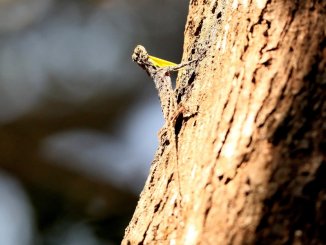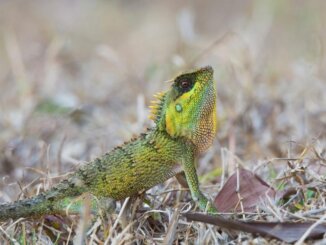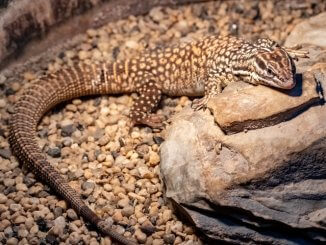The Jackson’s chameleon is a vibrant green, blue, and yellow lizard that is native to the mountain slopes in Tanzania and Kenya. The Hawaiian Islands now houses a large invasive population of Jackson’s chameleons.
Beginner chameleon keepers will find it easy to care for Jackson’s chameleons. These lizards are docile and easygoing and are a popular choice for first-time pet owners.
Jackson’s Chameleon Overview
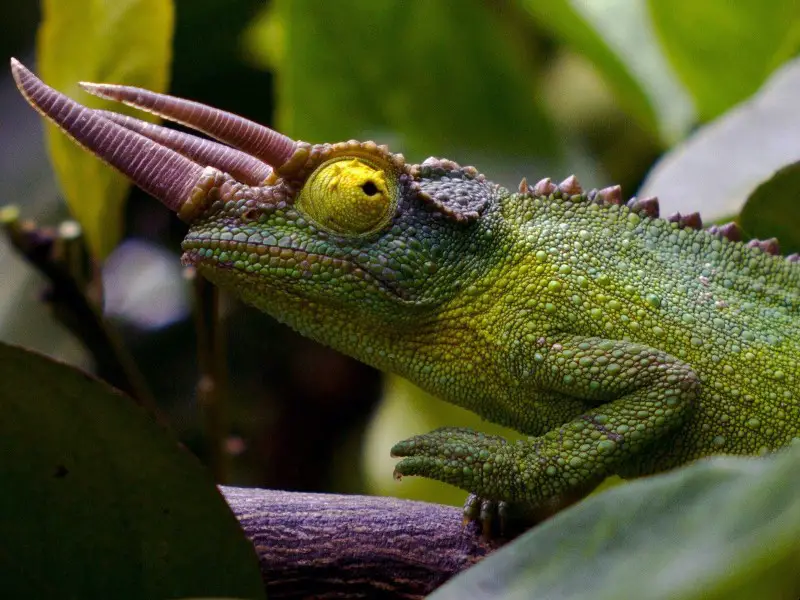
| Common Name(s): | Jackson’s chameleon, Jackson’s horned chameleon |
| Scientific Name: | Chamaeleo jacksonii xantholophus |
| Natural Habitat: | Mountain slopes in Tanzania, Kenya, and the Hawaiian Islands |
| Adult Size: | 7–14 inches |
| Average Lifespan: | Up to 9 years (males), 5–6 years (females) |
| Diet: | Insectivorous |
| Housing: | 18 x 18 x 36 inches minimum, 60–80°F, 50 to 80 percent humidity |
| Experience level: | Beginner |
Origin
The Jackson’s chameleon (Chamaeleo jacksonii xantholophus) populates the trees of rocky slopes in Tanzania, Kenya, and the Hawaiian Islands. This chameleon prefers a habitat with plenty of trees to live in and rarely ventures to the ground unless to mate or lay eggs.
Jackson’s chameleons are classed as “threatened” by CITES because of habitat destruction and because these lizards are captured and sold illegally in the exotic pet trade.
As a diurnal, arboreal lizard, the Jackson’s chameleon is active during the day and blends into its environment, appearing tree-like.
Appearance and Behavior
Jackson’s chameleons start their life as brown lizards. At about five months old, they develop their bright green coloration. Jackson’s chameleons can change color depending on their temperature, mood, or intent. However, these lizards don’t alter their colors for camouflage.
Male Jackson’s chameleons are larger than females. Males have a vivid coloration, with bright yellow or blue markings. The three forward-facing horns on the male Jackson’s chameleon’s head give it the nickname “three-horned chameleon.” Females occasionally have three brown horns, but these are smaller than the males’.
Because of their bright colors and triceratops-like horns, male Jackson’s chameleons are more interesting to look at than females.
Size and Lifespan
The average size of a Jackson’s chameleon is from seven to 14 inches. Male Jackson’s chameleons are slightly larger than females.
Jackson’s chameleons live longer than most chameleons. Female Jackson’s chameleons live for five to six years, whereas males live up to nine years.
Because male Jackson’s chameleons live longer and have a more interesting appearance, they’re more sought-after than females.
Temperament
Jackson’s chameleons are laid-back and docile. However, they are solitary, territorial lizards and prefer to live alone. If you buy more than one Jackson’s chameleon, you should keep the lizards in separate tanks. Even if the chameleons don’t fight with one another, they might become ill or die from stress.
You can handle a Jackson’s chameleon, but it’s better not to. Touching or holding a Jackson’s chameleon can cause it distress. Because of this, these lizards are a good choice for people who don’t mind watching but not touching their pets.
Housing Jackson’s Chameleons
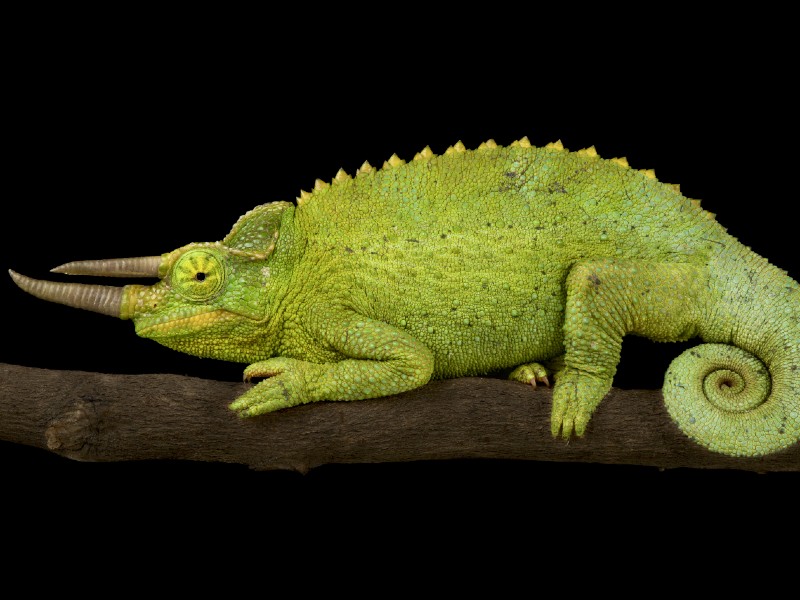
Jackson’s chameleons live in forests and mountain thickets in the wild and need leafy cover to hide in. Your lizard tank should replicate this environment, with lots of greenery and large branches for your lizard to sleep on.
You should keep a Jackson’s chameleon in a screened enclosure or in a well-ventilated terrarium.
Enclosure size
The minimum tank size for an adult Jackson’s chameleon is 18 x 18 x 36 inches. If you can provide more space for your Jackson’s chameleon, you should do so. The best choice for long-term housing is a larger enclosure of 24 x 24 x 48 inches.
Make sure your enclosure is tall enough to place trees and branches up high for your Jackson’s chameleon to climb.
Lighting
Your Jackson’s chameleon’s tank should have a full-spectrum UVA or UVB light source.
Full-spectrum UV lights are essential to a chameleon’s health. These lamps enable your Jackson’s chameleon to produce vitamin D, which prevents metabolic bone disease. Vitamin D is also needed to metabolize calcium for nervous system, bone, and muscle health.
If you decide to add live plants to the enclosure, a full-spectrum lamp will help your plants to grow.
Like humans, Jackson’s chameleons are most active in the day. You should set your UV light on a timer for between 10 and 12 hours to represent daylight hours. Read the manufacturer’s instructions to learn how often the bulb needs to be replaced. You will usually need to change the bulb every six months.
If you live in a hot climate, you can take your chameleon outdoors for a dose of natural sunlight. However, Jackson’s chameleons can’t tolerate temperatures above 90 °F, so monitor outdoor temperatures carefully if you plan to house your chameleon outdoors.
Temperature and Humidity
Jackson’s chameleons require different temperatures to mimic daytime and nighttime in their enclosure.
A daytime temperature of between 70-80 °F is suitable, with a separate area for basking. This basking area should be set to a maximum temperature of 85 °F.
You can use a ceramic heating element to accomplish your enclosure’s daytime temperature. A basking light or heat pad can be used for the basking spot. Place lamps outside of the enclosure to prevent burns.
Jackson’s chameleons enjoy the heat but are used to living in a shaded environment. Provide plenty of shade and a space for cooling off in the enclosure.
Set your enclosure’s nighttime temperature to 60°F. If 60°F is your home’s natural temperature, you can switch off the heat lamp overnight. Otherwise, adjust your heating element to provide less heat during the night.
Jackson’s chameleons are used to high daytime humidity of up to 100% and nighttime humidity of 30%. Stimulate this humidity in the enclosure to ensure your pets stay happy and healthy.
Use two digital hygrometers to monitor your enclosure’s humidity levels. Place one hygrometer on each side of the enclosure to get the clearest humidity reading.
You shouldn’t keep a steady humidity, as this can cause mildew and mold. Instead, use automatic misting systems that are set to mist the tank for up to six hours per day.
Like most chameleons, Jackson’s chameleons shed their skin to renew skin cells and facilitate growth. Make sure humidity levels are adequate during shedding, as this will allow your chameleon to shed comfortably and thoroughly.
Substrate and Decoration
Jackson’s chameleons don’t require substrate because they spend most of their time above ground. A paper towel, newspaper, or no substrate at all, is fine.
You shouldn’t use wood chips or any material that a Jackson’s chameleon could mistake for food. This could cause blockages if eaten by your chameleon.
This lizard doesn’t need fake rocks or caves in its enclosure either. Instead, fill the enclosure with sticks and plants (either fake or real). This will give your chameleon plenty of space to climb and hide. If you choose live plants for your enclosure, make sure they’re non-toxic. Ficus is a good plant for a Jackson chameleon’s enclosure.
Cleaning
A clean tank will prevent mold and mildew and is essential for the health of a Jackson’s chameleon.
Every day, remove waste and food (including dead and live insects) from the enclosure. Use a chameleon-friendly antibacterial cleaner to wipe down the enclosure and wipe away any pooling water.
Once a week, remove the bottom section of the enclosure and give the tank a deep clean. To make cleaning easier, line the bottom of the enclosure with newspaper or paper towels. Remove this lining and replace it with fresh lining when you clean the tank.
Don’t remove all the plants from the enclosure, as this will stress out your Jackson’s chameleon. It’s better to remove one plant per week and clean the plants on a rotation. You should wipe down the leaves and branches with a damp sponge.
While cleaning, place your chameleon in a separate backup cage out of the way. The cage doesn’t need to contain a UV lamp. Instead, you should place the cage outside in the sunlight to help your Jackson’s chameleon feel most at home in its temporary environment. Adding a familiar plant to the backup tank will also calm your chameleon.
Jackson’s Chameleon Care

Jackson’s chameleons are hardy and easy to care for. With the right tank conditions, your chameleon should feel in its element. However, Jackson’s chameleons are susceptible to several health problems.
Food and Water
Quality nutrition is important for a healthy Jackson’s chameleon.
Jackson’s chameleons are insectivores, so their diets consist of bugs like crickets, locusts, stick insects, flightless fruit flies, and locusts. Feed your chameleon a variety of these bugs for a balanced diet. You can also feed your Jackson’s chameleon treat foods, such as mealworms, waxworms, and butterworms. Due to their high-fat content, these treats should be limited to one feeding per week.
All prey should be smaller than the gap between your Jackson’s chameleon’s eyes. This will prevent choking.
Stick to a set feeding schedule for your chameleon, depending on its age:
- Young Jackson’s chameleons aged one to three months should be fed as much food as they can eat, twice a day
- Juvenile chameleons between three to six months old should eat between 10 and 12 small bugs per day
- Chameleons aged six to12 months should eat between eight and 10 medium bugs per day
- Adult chameleons aged one year or above should eat six to eight large crickets per day.
Your Jackson’s chameleon’s individual biorhythm may be different, but this is a good template to use. Don’t overfeed your chameleon, as doing so can cause obesity.
You shouldn’t feed a Jackson’s chameleon fireflies or insects caught in the wild. Fireflies are toxic to chameleons, and wild insects are more likely to carry parasites.
Most Jackson’s chameleons prefer to drink rainwater or pools of standing water on the ground. There are water bowls available for chameleon enclosures. However, your Jackson’s chameleon is more likely to use this bowl as a toilet rather than a drinking source.
You can purchase a water bowl if you’re worried about your chameleon getting enough water. A tank mister is the better option because it mimics rain. Your chameleon will learn to drink directly from the nozzle of the mister during misting periods. The water in your mister should be normal tap water, which will provide essential minerals to your chameleon.
Handling
Jackson’s chameleons are solitary creatures that prefer to stay in their own familiar environment. If you’re looking for a pet that tolerates being held and petted, Jackson’s chameleon isn’t right for you.
Taming your chameleon is important, and this requires some handling. A tame chameleon will be easy to handle during enclosure cleaning and trips to the vet.
Here’s how to tame your Jackson’s chameleon:
- Leave your chameleon alone for a couple of weeks after bringing it home. This will allow your chameleon to adjust to its environment. For now, feed your chameleon from a distance.
- Feed your chameleon directly, holding an insect in your hand. Stay at least six inches away from your pet. Your chameleon may not take the prey at first. Repeat this process for several days until successful.
- When your chameleon regularly eats from your hands, hold your hand out as a perch, and encourage your chameleon to come to you. It could take several days to weeks to gain your chameleon’s trust.
You should never grab your chameleon or pull it out of its cage. Grabbing is seen as predatory behavior and will damage your chameleon’s trust. Grabbing may also injure your chameleon.
If you do choose to handle your Jackson’s chameleon, associate handling with positive things, like snack time or sunny windows. Handling can be stressful for Jackson’s chameleons, but it’s easy to bribe these reptiles. Keep your movements slow and limit your handling to up to 10 minutes, twice a week.
Common Health Issues
Jackson’s chameleons can suffer from a number of common health issues, discussed below.
Dehydration
Dehydration can cause serious illness and death. A dehydrated Jackson’s chameleon may have sunken eyes, orange/yellow urate, lethargy, and a loss of appetite. To prevent dehydration, make sure that your enclosure isn’t too hot and your humidity is high enough. If your chameleon drinks from a mister, prolong misting periods in the tank.
Eye problems
If your chameleon has swollen or weeping eyes or is rubbing its eyes frequently, book an appointment with your vet. Eye problems can be a sign of dehydration, vitamin A deficiency, or bacterial infection. Poor ventilation can be responsible, so ensure your enclosure is well ventilated.
Intestinal parasites
Parasites such as pinworms and roundworms can suppress a Jackson’s chameleon’s immune system and result in sickness. Poor tank hygiene and wild insects can increase the risk of parasites. If your chameleon isn’t eating or toileting as usual, book an appointment with your vet.
Metabolic bone disease
Metabolic bone disease, or MBD for short, can be caused by imbalanced nutrition, a lack of dietary calcium, or no UV light. Lethargy, swollen or curved limbs, muscle spasms, and a loss of coordination are all signs of metabolic bone disease. This condition requires urgent veterinary treatment.
Respiratory infection
A respiratory infection is caused by incorrect humidity and low temperatures in captivity. Poor ventilation can also cause respiratory infections. If your chameleon is panting or wheezing and has foamy saliva or mucus around its nose, visit a certified reptile veterinarian, who will prescribe antibiotics to treat the condition.
Supplement Requirements
Supplements are a good way to provide your Jackson’s chameleon with additional nutrition. However, Jackson’s chameleons are used to making the most of whatever they can find in the wild, so keep supplements to a minimum.
Calcium powder can prevent your chameleon from experiencing high potassium to calcium ratio. Sprinkle calcium powder onto your chameleon’s food to prevent sickness.
Your chameleon will also need vitamin D3 supplementation, even if you have a UV light. Calcium supplements that contain a small amount of vitamin D3 are available for this purpose.
Breeding
It’s easy to breed Jackson’s chameleons, but these creatures can be lazy. You should only attempt to breed a pair of chameleons if you’re prepared to raise up to 30 babies.
Jackson’s chameleons are ready to breed from approximately nine months old. To breed a pair of Jackson’s chameleons, follow these steps:
- Choose a healthy male and female. Place the female in the male’s enclosure. Leave the pair for up to three days.
- If no breeding has occurred, show the male his mirror image. He will think he has competition and will be enticed to breed with the female.
- After breeding has occurred, the female will incubate her neonates in a soft shell inside her body. Gestation for the first brood lasts up to nine months.
- Female Jackson’s chameleons can store sperm, so the chameleon mother may give birth to several other broods every three months.
Choosing and Buying a Jackson’s Chameleon
Jackson’s chameleons cost $50 to $150 on average. Males are more vibrant and have longer lifespans than females, so you can expect to pay more for a male Jackson’s chameleon.
Jackson’s chameleons are allowed to be bred and sold, but it’s illegal to catch and sell wild Jackson’s chameleons.
To ensure your chameleon has been raised with care, you should buy from a reputable breeder. Your chameleon should have bright, alert eyes, and bright green skin. After buying a Jackson’s chameleon, you should take it straight to a vet to check for parasites.

